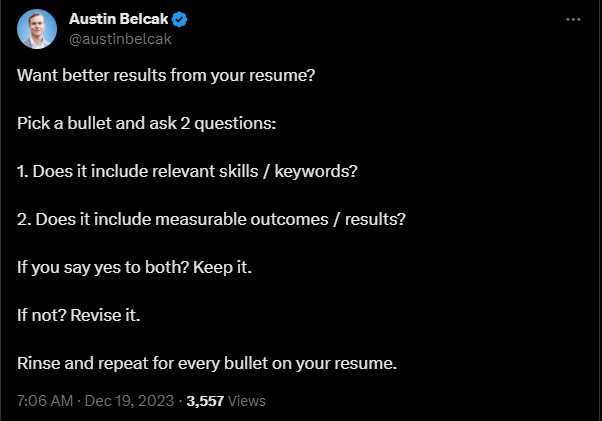Best Practices for Beating an Applicant Tracking System in 2024
In today's digital age, job application processes have become largely automated, with companies across the world leveraging technology to streamline their recruitment. One such technology is the Applicant Tracking System (ATS), which plays a critical role in filtering out resumes and selecting the most suitable candidates for a job. This article will delve into what an Applicant Tracking System is, how it operates, and most importantly, how to get your resume past it.
What is an Applicant Tracking System?
With the advent of online job application boards recruiters can post a position for 24 hours and receive over 1000 applications. Even if a recruiter were to take only 10 seconds to review each resume the recruiter would have 3 hours of work just do get through initial resume screening. This excludes follow up with qualified candidates. Every recruiter has more than one job requisition and they are evaluated on the time to fill so manual completion of the basic recruiting tasks was not scalable. The solution: applicant tracking systems. The primary purpose of an applicant tracking system is to manage the recruitment process efficiently. It is a software application that enables companies to handle job applications and select the most qualified candidates based on specific criteria. The system scans and sorts the resumes, checking for the required qualifications, and selecting the candidates for an interview.
ATS has become an integral part of large companies' recruitment process, especially those that receive a high volume of applications. Whenever you apply for a job online, it is highly likely that your resume is first scanned by an ATS. If you are applying to jobs you are qualified for, but you are not receiving follow up. Follow up in the form of screening calls from recruiters or talent acquisition specialists then you have a resume problem or roadblock. The same goes for if you are very quickly being rejected from consideration for jobs you apply to.
Applicant Tracking Systems offers numerous benefits to employers, including saving time and resources in the hiring process, maintaining a database of applicants for future job openings, and ensuring a more streamlined, organized recruitment procedure. However, for job seekers, the challenge lies in ensuring their resume is ATS-friendly and can pass through the system successfully. The worst part for job seekers is that you have to understand recruiters and applicant tracking systems for the most success, but these are skills you are not taught in your formal education.
How do Applicant Tracking Systems Work?
ATS operates based on a specific algorithm and uses keywords to filter out the applications. When a job applicant submits their resume online, the system scans the document for specific keywords related to the job description. The system then ranks the resumes based on how well they match the job description.
If your resume includes the relevant keywords and meets the job criteria, the ATS flags it as a potential match, moving it forward in the recruitment process. If not, the system will ideally reject the application or, as many of you have experienced, the system does nothing with it for months.
While this automated system might seem ruthless, it's important to remember that it's designed to assist hiring managers in dealing with the vast number of applications they receive. The ATS's goal is not to eliminate potential candidates but to streamline the process and ensure that only the most relevant applications are forwarded for human review. That means your resume has to satisfy at least 3 stakeholders. The Applicant Tracking system, the recruiter or talent acquisition specialist, and the hiring manager/team.
Best Practices for Getting Your Resume Through an Applicant Tracking System
1. Apply for Jobs You Qualify For
While it might be tempting to apply for as many jobs as possible, it's crucial to focus on those roles that align with your skills, experience, and qualifications. ATS is designed to match the specific criteria mentioned in the job description, so applying for jobs you're not qualified for will likely result in your resume being dismissed by the system. One of the most common filters a recruiter will use when it comes to applicant tracking systems is educational background. If a position says it is nice to have a PhD or a Masters often the top candidates that are looked at and interviewed first have those nice to qualifications.
2. Be Selective About the Jobs You Apply for at One Company
Applying for multiple positions within the same company might seem like a good strategy to increase your chances of getting noticed. However, this can be counterproductive. It might give the impression that you're not clear about your career path or that you're desperate for any job. To maximize your chances of success, focus on specific roles that suit your qualifications and career goals.
3. Use Relevant Keywords
Keywords are the essence of ATS. The system scans your resume for specific words that match the job description. These may include job titles, skills, qualifications, or any other specific requirements. Ensuring that your resume includes these keywords is crucial to getting past the ATS. One strategy is to review the job description carefully and incorporate the same language and phrases used. Customizing your resume for each application is time consuming but this situation calls for quality > quantity.
4. Connect Your Keywords to Unique Experiences
While it's essential to include the right keywords, it's equally important to connect these keywords to your unique experiences and achievements. Instead of merely listing the keywords, demonstrate how you have used these skills or qualifications in your previous roles. This approach will add credibility to your resume and make it more compelling to hiring managers.
5. Include a Skills Section
A dedicated skills section in your resume can be useful for listing your core competencies and making sure all the right keywords are included. This section should highlight your technical skills, soft skills, and any specific tools or technologies you're proficient in. By providing a concise list of your skills, you make it easier for the ATS to identify your qualifications. Don't just take our word for it for what we have covered so far. Austin Belcak of
CultivatedCulture.com reinforces these ideas with the following framework:

6. Use Basic Language
While it might be tempting to use industry jargon or complex language in your resume, simplicity is key when it comes to beating the ATS. The system is programmed to look for specific words and phrases, so using clear, straightforward language will increase your chances of getting your resume noticed.
7. Write Out Acronyms
Although you might be familiar with specific acronyms related to your field, you shouldn't assume that the ATS will recognize them. To be on the safe side, it's best to write out the full term followed by the acronym in parentheses. This way, you cater to both the ATS and the hiring manager who might review your resume.
8. Submit a Tailored Resume for Each Job
A general, one-size-fits-all resume is unlikely to pass the ATS. Since the system scans for specific keywords related to the job description, you need to tailor your resume for each job you apply for. By customizing your resume to match the job requirements, you increase your chances of making it past the ATS and onto the recruiter's desk.
9. Keep Your Resume Simple
Fancy formatting, graphics, or unusual fonts can confuse the ATS and lead to your resume being rejected. Stick to a clean, simple resume format with standard fonts and bullet points to ensure that the system can easily read and process your information. A good way to test if your resume is being read correctly is if you apply to any workday application using a resume. If you have to make manual changes to the application after the ATS scans and autofills the application you have work to do on your resume.
10. Use Basic Formatting
In addition to keeping your resume simple, you should also use basic formatting to make it ATS-friendly. Avoid using headers or footers as the ATS might not recognize this information. Instead, place all your details within the main body of the resume. Also, use standard section headings like "Work Experience," "Education," and "Skills" to ensure the ATS correctly categorizes your information.
11. Submit the Right Type of File
The file type you choose when saving your resume can also impact its ATS compatibility. While some job postings specify the required file type, if not specified, it's safest to stick with a Word document or PDF. These formats are most likely to be compatible with the ATS.
12. Update Your Information Online
In today's digital age, many employers use online platforms to source candidates. Therefore, it's crucial to ensure your online profiles, like LinkedIn, are updated with the same information as your resume. This will help create a consistent professional image and increase your chances of passing the ATS.
13. Include Internal Referrals in Your Application
In some cases, a referral can significantly increase your chances of getting your resume past the ATS and in front of a hiring manager. If you know someone within the company, consider asking them for a referral.
Practical Application for Resume Optimization
To optimize your application process when you are targeting a specific type of role I have recommended my many clients create a resume template. To build a resume template look at 10 job descriptions from different industry leading companies for the target role. While looking at these job descriptions note how many time each skill, task, and qualification is mentioned. Then take the most common items and include them in your resume template.
Remember this is a template so you may end up exceeding the recommended 475 to 600 word limit for your resume. If you do exceed the word limit recommendation be sure to remove irrelevant items during the customization process. You will still need to customize the resume for each application as each job description is going to have slight variations in language. Changing your resume to use the language from the job description is the best practice to ensure you pass the ATS.
Conclusion
In conclusion, understanding how an Applicant Tracking System works and tailoring your resume accordingly can significantly increase your chances of landing your dream job. Remember that the purpose of an ATS is not to eliminate candidates but to help employers manage a large volume of applications efficiently. By following these best practices, you can increase your odds of beating the ATS and getting your resume noticed.
If you have enjoyed this article please share on social media and with a friend because this expands Acquired Salary's reach which is important to helping allow us to continue to keep making free valuable content. Interested in taking your career or business to the next level schedule a consultation call Today!
Career Mastery Community

How to get a promotion in less than 90 days and learn the 3 pillars to increase your Salary by 30% or more.
More Career Tips, Tricks & Tools
Blog



